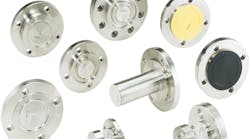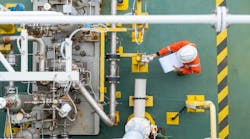Rolling bearings in all their many types and arrangements function as critical precision components in industrial rotating machinery. They serve to reduce friction, power consumption and heat generation while simultaneously supporting increasingly heavier applied loads at higher speeds with a higher degree of accuracy. Ultimately, they help promote optimized machinery performance and reliability.
Regardless of the application, all bearings share basic requirements for ideal operation. They must be properly stored prior to installation, mounted according to best practices and appropriately lubricated, among other fundamentals.
Based on frequently asked questions, following are insights that can prove useful in achieving the full potential of bearings and associated technologies.
Tips for proper storage
Rolling bearings should be stored in a cool, clean, low-humidity environment at a steady temperature and free of dust, shocks and vibrations.
Among other recommendations, bearings should lay flat (rather than on end) and be kept in their original, unopened packages until just before mounting. If stored in a standing position, the likelihood of false brinelling (frictional corrosion of the raceways by the rolling elements caused by external vibrations) increases significantly. Vertically stored bearings can also topple over, which may damage the bearing when it falls.
In the cases of sealed or shielded types of bearings, operators should be cautious when storing them over long periods of time. The lubricating properties of the grease used to fill these types of bearings may deteriorate, causing potential lubricant-related problems when a system is up and running. As guidance, most bearing manufacturers have specific shelf-life limits, which are based on the grease used in their sealed/shielded bearings.
Best mounting practices
When the wrong tools or improper mounting techniques are used, bearings can easily be damaged or installed incorrectly. This can lead to poor bearing performance and a shortened bearing service life.
Overall, the mounting environment needs to be clean and free of any contaminants or corrosive fluids. This includes the working surface, hands/gloves and tools.
The most effective and popular mounting techniques can be divided into three main categories: mechanical mounting, hot mounting and hydraulic mounting. Mechanical mounting (also known as cold mounting) is generally recommended for small- and medium-sized bearings with outside diameters up to 4.0 inches (100 millimeters). Hot mounting and hydraulic mounting methods can be used for all bearing sizes but are mainly used for medium- to large-sized bearings.
Mechanical mounting uses a mounting force sufficient to overcome the interference fit between the bearing and the shaft and/or housing components. The appropriate fitting tool should be positioned to apply the mounting force to the ring with the interference fit. The mounting force should never be directed through the rolling elements because this will damage the raceways.
Hot mounting involves heating the bearing prior to installation to a specific temperature (175°F to 250°F, depending on the bearing design) so the bearing bore will expand radially. This temporary expansion of the bearing bore allows for easy installation onto the shaft to overcome the shaft interference fit. Once the bearing cools and returns to room temperature, the intended shaft interference fit with the bearing bore is achieved. Utilizing an induction heater with adjustable thermostats and demagnetization cycle is the cleanest, most reliable and efficient technique to heat bearings for mounting (see Figure 2). An open flame should never be used to heat a bearing.
For larger bearings or applications with precision mounting requirements, hydraulic techniques — including hydraulic pumps, oil injectors and hydraulic nuts — deliver the goods. This mounting method is typically used when mounting bearings with tapered bores. Such bearings may be mounted either on tapered shaft journals or on adapter sleeves and are mounted on the tapered surface by the use of the hydraulic pressure. Hydraulic mounting methods allow for more control and further help to maintain precision, accuracy, speed of installation and repeatability; minimize the risk of damage to bearings and shafts; require less manual effort; and promote operator safety.
Figure 2. An induction heater is a technology that can be used to heat bearings prior to mounting.
Grease versus oil lubrication
Lubricant separates a bearing’s rolling and sliding contact surfaces, prevents wear and reduces friction and heat generation. The lubricant also protects against corrosion, carries away heat (in the case of oil) and helps keep out contaminants (in the case of grease).
When feasible, grease is typically the preferred bearing lubrication choice because it is easy to apply, easier to retain within a bearing’s housing and improves sealing against solid or moisture contamination.
Lubricating greases consist of a mineral or synthetic base oil that is suspended in a thickener or soap. Additives may also be introduced to impart characteristics such as protection against wear or corrosion and friction-reducing properties. By varying base oil viscosities, thickeners and additives, greases can be developed with distinct characteristics to satisfy particular applications and operating conditions.
Oil lubrication will usually be specified when high speeds, high temperatures or lubricant life and cleanliness preclude the use of grease. When application conditions permit, the advantages of oil include easy filling and draining, increased bearing speed capability, reduced heat generation and the capability to filter contaminants from the lubricant.
Mineral oils represent the most common oil lubricant choice for rolling bearings because of their good performance for a wide range of applications. Synthetic oils are usually selected in extreme cases such as very low or very high operating temperatures or when the oil service life needs to be extended. Rust and oxidation inhibitors are typical additives for extending the life of lubricating oils, and extreme pressure and antiwear additives are used in special cases to reduce bearing wear and extend bearing life.
Making the critical lubrication decisions will contribute to success or failure of equipment in service — but decision-making can become complicated since no single universal lubricant exists to cover all application scenarios. A knowledgeable lubrication specialist can help identify and implement best lubrication practices for the application.
Compensating for misalignment
When an electric motor, turbine or other driver is coupled to a pump, fan, gearbox or other equipment, the shafts and coupling of the two must be properly aligned. Otherwise, parallel or angular misalignment between the two machines will cause increased stress on the shafts, seals and rolling bearings, which will jeopardize the machinery health and operation.
Bearing misalignment can be caused by shaft deflections (bending) under applied loading, tolerance errors associated with the shaft and housing, uneven bearing support surfaces, and alignment errors between coupled shafts or components. Excessive misalignment will result in increased internal loading, friction, heat generation and decreased bearing life.
Conventional rigid bearings have strict limitations for misalignment: Approximately two to 10 minutes of arc for deep groove ball bearings and angular contact ball bearings, and approximately two to four minutes of arc for cylindrical roller bearings and tapered roller bearings. This limited capability led to the development of self-aligning bearings engineered to accommodate much higher misalignments.
The self-aligning bearing has a raceway curvature based on a sphere, which will self-adjust to the misaligned conditions of the shaft and housing (see Figure 1). The self-aligning capability can also accommodate initial misalignment caused by machining or mounting errors. Types include self-aligning ball bearings, spherical roller bearings, toroidal roller bearings and spherical roller thrust bearings.
Other bearings compensate for misalignment with the use of sphered outer diameters, which can misalign within a mating sphered surface. Types include unit ball insert bearings and alignment needle roller bearings. Their precise misalignment capability depends on the specific bearing size and design.
Values for the permissible misalignment will be supplied by the bearing manufacturer, which also can assist when the expected misalignment in an application will exceed the permissible limits.
An understanding of the fundamental basics of rolling bearings can provide a big assist in meeting application requirements and demands and in promoting successful outcomes for bearings in service.
Brian P. Dahmer is director of engineering experts at SKF USA Inc., based in Lansdale, Pennsylvania. He can be reached at [email protected] or 267-436-6517.



